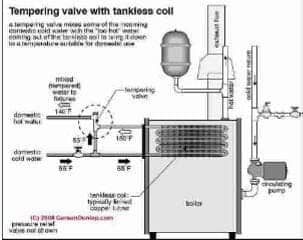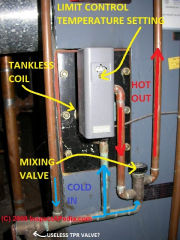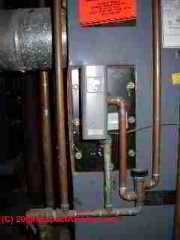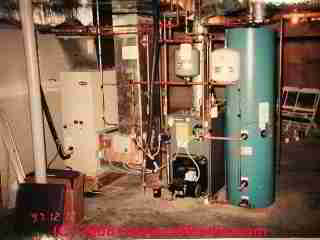 Tankless Coil Hot Water Conversions
Tankless Coil Hot Water Conversions
Should I Use a Tankless Coil to Heat a Separate Water Tank?
- POST a QUESTION or COMMENT about the procedure for abandoning a tankless coil to use other methods for making hot water
Abandoning or converting a tankless coil hot water heating system:
Hot water supply improvements by converting from a tankless coil to something else. This article explains whether or not it makes sense to convert tankless coil used for making domestic hot water into an alternative hot water system such as using it to heat a separate hot water tank.
InspectAPedia tolerates no conflicts of interest. We have no relationship with advertisers, products, or services discussed at this website.
Converting a Tankless Coil to Indirect Water Heating
What is the difference between an indirect-fired water heater and the tankless coil on a heating boiler?
An indirect-fired water heater tuses a separate reservoir tank of "hot water" that is heated by circulating hot water from the heating boiler (photo below-right, short and gray to left of the tall blue water tank) through a heat exchanger "coil" mounted in the bottom of the water tank.
The domestic hot water used by the building occupants is inside the water tank. The quantity of hot water available is a function of the size of that tank, typically 50 gallons, plus the operating temperature range (higher temperature + mixing valve gives more than 50 gallons of hot water).
At INDIRECT FIRED WATER HEATERS we describe indirect-fired water heaters in detail.

A tankless coil hot water system uses a finned copper coil inserted right into the hot heating boiler (photo above right) water to heat domestic hot water as water is run through the interior of the coil.
Heat from the boiler water is transferred through the coil fins and tubing into water passing through the interior of the coil on its way to the user. Unlike the 50-gallon indirect-fired water heater (above left) the tankless coil (above right) has a reservoir of zero gallons of hot water. Instead, it has a reservoir of "heat" - the heat that is inside the boiler, available to be transferred to the coil.
Why do people convert from using a boiler-mounted tankless coil to indirect-fired water heaters?
The specifications for a typical tankless coil / hot water heating boiler indicate that the maximum flow rate through the coil has to be limited, say to perhaps 2.5 to 5 gallons per minute. Running hot water faster than that will mean the hot water isn't so hot - it needs time (slow passage through the coil) to absorb heat, and it means that you will run out of hot water sooner (sucking heat out of the boiler faster).
Those specifications also typically promise only 5 minutes of hot water supply (that's 25 gallons). Actually some happy users of tankless coils get more than that by combining a flow restricter, high boiler set temperature, and a tempering valve or mixing valve
(see MIXING / ANTI-SCALD VALVES) at the coil .
At HOT WATER QUANTITY IMPROVEMENT we discuss various ways to get more hot water in a home. One of these
Which gives me more hot water: a tankless coil on a boiler or an indirect-fired water heater?
Question: can a tankless coil on my heating boiler ever provide as much hot water as from a separate hot water tank tyhpe system?
The short answer is probably not. Let's mention the performance limits of a conventional boiler-mounted tankless coil. Keep in mind we're talking about a finned copper coil immersed into the heating water found inside a home heating boiler whose primary design purpose was heating the home, not making domestic hot water for washing and bathing.
The hot water quantity available from a tankless coil:
The hot water flow rate - how much hot water you can run at a time or how fast you can run hot water out of one or more plumbing taps:
Reader Comments, Questions & Answers About The Article Above
Below you will find questions and answers previously posted on this page at its page bottom reader comment box.
Reader Q&A - also see RECOMMENDED ARTICLES & FAQs
Question: How do I hook up a circulating pump and hot water tank to an existing tankless coil system?
I am looking for information about connecting a circulating pump and hot water storage tank to an existing tankless coil that can't produce hot water fast enough. My boiler is and old one, and I am trying to get the most out of it before replacing everything. - A Rossini, Katonah NY
Reply:
 If you converted a conventional tankless coil on a heating boiler to try to use it to heat a separate tank of hot water instead of simply feeding building water through the coil for heating, you'd be constructing an older type of water heater - a range boiler RANGE BOILER WATER HEATER for a discussion of that method.
If you converted a conventional tankless coil on a heating boiler to try to use it to heat a separate tank of hot water instead of simply feeding building water through the coil for heating, you'd be constructing an older type of water heater - a range boiler RANGE BOILER WATER HEATER for a discussion of that method.
A similar method, using a "side arm coil" on a heating boiler, is described at SIDE ARM COIL WATER HEATER.
What about converting an existing coil to something like one of those alternatives to get more life out of the coil? We're not sure it's an economical idea. As a primary water heater, feeding water through an existing tankless coil but no longer directly to the building but rather using it to heat a reservoir of hot water in a tank by recycling until the water in the tank is as warm as desired, you'd need to buy and install:
- extra piping, control valves, and check valves
- a new circulator pump dedicated to circulating hot water through a separate water tank and through the coil on the boiler
- a thermostat that controls turning that circulator pump on and off as needed (the temperature of the water in the coil on the boiler would handle turning the boiler on and off as needed)
It would be unusual to convert a tankless coil to an indirect fired water heater setup just to get more hot water - since the cost of doing so is at risk of being wasted when the coil wears out or becomes clogged. When the coil is shot and you're ready to buy a real indirect water heater, almost nothing of what you bought in our list above will be useful: normally those parts come packaged with the new Indirect-fired Water Heaters (that will still work using the existing boiler) or with a new High Efficiency Water Heaters that works on its own.
The total parts and labor cost of doing the temporary conversion of a tankless coil water heater, if we ignore having to later toss those parts away, is probably similar to buying a new indirect-fired water heater system that comes with all those parts. The difference is that an indirect-fired water heater from the factory will have the coil inside the water heater tank rather than inside the heating boiler. See INDIRECT FIRED WATER HEATERS for an explanation of indirect water heaters.
Alternatively as a booster system we sometimes see a plumber feed the house hot water piping straight from a separate water heater but boost-heat water leaving the water heater when needed by running it through the coil.
There are a couple of approaches or variations such as installing an electric water heater (cheap to buy, most costly to operate), leaving it turned off, and letting it simply hold incoming cold water in a reservoir that warms slowly in the utility room overnight. That approach "pre heats" the water into the coil by stealing heat from the basement. Then if hot water demand is high, say from visiting guests, the owner simply turns on the electric water heater.
If you are having tankless coil problems or are not satisfied with it, take a look at these articles:
- TANKLESS COILS provides detailed articles about maintaining and using a tankless coil hot water system
- ALTERNATIVE HOT WATER SOURCES compares alternative ways to make domestic hot water.
- The characteristics of various water heaters such as life expectancy, cost, safety, and capacity are discussed
at WATER HEATER COMPARISONS, PROPERTIES - Ways to improve total hot water quantity, pressure, temperature and flow are discussed beginning
at HOT WATER IMPROVEMENTS and continuing at HOT WATER QUANTITY IMPROVEMENT.
Question: Water entering my indirect-fired water heater tank still flows through the old tankless coil
I have an indirect water tank that is plumbed as a zone (has its own circulator). However, the "cold" input to the tank is actually from the output from my tankless coil - it was never removed or disabled. So, when I ask for hot water, the cold water that enters the boiler can trip the thermostat and the boiler will run; even though there is plenty of hot water in the tank. In effect, the water is pre-heated before it gets to the tank. I'm guessing that the tank circulator doesn't run much unless the water draw outruns the tankless. Seems like a sub-optimal configuration. Thoughts?
Reply: Here are what the different pipes and controls do on an indirect-fired water heater, and here are some options regarding the old tankless coil
Let's be sure we understand the four pipes that should be present: cold in, hot out hot water supply to the home, and a second loop that circulates hot heating water from the boiler through a heat exchanger coil inside the tankless water heater.
Usually an indirect water heater is heated by a coil in the bottom of the heater tank; inside that coil circulates water piped from the boiler - indeed it looks like just another heating zone, and the pipes into and out of the water heater bottom connect to the boiler just as do other zone piping, that is, they are not connected to the tankless coil at all.
If that's what you have, but your indirect water heater is receiving its incoming cold through a tankless coil on the heating boiler, you are "double-heating" your hot water, probably unnecessarily. If it were my set-up and I wanted to keep the tankless coil available on that heating boiler, I'd run things the other way. I'd run cold into the indirect water heater first, let the indirect water heater heat up the cold water, and run the hot water out of the indirect water heater on to supply house hot water. That avoids the clogged tankless coil problem that occurs in areas with hard water.
Often an indirect water heater is installed as an improved source of hot water giving better quantity, more efficient boiler operation, and avoiding poor hot water flow due to clogged tankless coil.
You could run the hot output from an indirect water heater through the coil so it can act as a booster in times of extra-high hot water use. If I were doing this I'd use control valves that let me put the tankless coil in or out of the loop - I would not always run my hot water through the tankless coil and boiler - doing so risks clogging the tankless coil that much faster and reducing the hot water flow rate in the home.
If the tankless coil is heating a a coil in your indirect water heater, acting as a "zone" as you describe, then you can't disable it as it's the heat source. (This would be an unusual installation
Reader follow-up:
yes, I have the "pre-heat" config as you described. cold into tankless, then on to water heater, hot water out from WH. Coil inside WH is plumbed as a zone (boiler water, not tankless water). The config was plumbed with valves, so I could bypass the tank (failure, repair,etc) and go back to just tankless. I think I just need to re-route the cold in from the tankless to the WH. tnx.
one other thing...the WH zone is not controlled by an aquastat, so it only triggers the low limit. I guess I don't see a huge problem with this, although triggering the high limit temp would heat the water faster.
Reply:
Chris the way your system is hooked up is not as efficient as the usual indirect-fired water heater, though it'll work.
And to clear up a point about thermostatic controls on heating equipment: in most cases the thermostat, whether it's a wall thermostat in a room or an aquastat controlling hot water temperature, the thermostat itself functions just as an "on-off" switch. So setting the thermostat to a higher number won't heat the room (or the hot water) any faster. The rate of heating up hot water depends on the BTU rate of the burner.
What will make a related difference in hot water performance howerver, is setting controls so that the heating device comes on sooner and so that it heats water to a higher end-temperature before turning off. Just be sure that an anti-scald device is installed and set properly. We discuss these settings at AQUASTAT CONTROL FUNCTIONS.
Question: What Aquastat Settings Should I Use or Change if I Discontinue Use of a Tankless Coil?
Regarding What are the Best High, Low, & DIFF Settings on a Heating Boiler Aquastat?
I am just looking to clarify what I believe I read in your article, and how it applies in my current set-up. I live in the Northeast USA, and use programmable thermostats for the 2 zones in my home. I have a Burnham Oil Boiler that originally had a tankless hot water coil installed in it. Recently I abandoned that coil, and I had installed a separate tankless gas hot water heater to supply hot water for the home. The coil is still in the boiler, but is now capped off, and is longer is connected to my hot water plumbing supply.
It seems to me, that I should disable the the DIFF and LO settings, as per your section in this article "Guide to Disabling the LO and DIFF settings on a Boiler that Does Not Use a Tankless Coil for Domestic Hot Water" In that section it calls for disconnecting a wire from the aquastat which it seems will in effect disable both the LO and DIFF settings. If that is correct, and I disconnect that wire, then my boiler will only heat up when the thermostat calls for heat to be sent via the circulator pumps to the appropriate zones.
These are my questions:
Does this mean that now the boiler will go cold until the thermostat calls for heat (I set the HI to 200°, as per your article)?
And if so, that would mean that in the summer, the boiler will not come on at all, and if so is there any risk of damage to the boiler? I.e.: The Tankless Hot Water Coil Plate has a rubber gasket sealing it on the boiler, could that leak?, Etc...
Or, Should I just set the LO and the DIFF to their lowest settings? - C.C.
Reply:
Does this mean that now the boiler will go cold until the thermostat calls for heat (I set the HI to 200°, as per your article)?
Yes the boiler should not run except on a call for heat - basically you're turning off the circuit that would have kept heat in the boiler in the summer time
And if so, that would mean that in the summer, the boiler will not come on at all, and if so is there any risk of damage to the boiler?
Yes, the boiler could suffer from
- leaks if it's one of certain older cast iron models on which leaks might occur between boiler sections at push nipples when the boiler goes stone cold; if your unit is steel you're ok; or ask your heating company if your cast iron boiler is one that leaks when cold.
- leaving the heat off also can lead to hardening of the soot/crud left in the boiler at the end of the heating season, making cleaning harder later on - which is a problem that can occur in any case; we recommend cleaning and servicing the boiler at the end of the heating season
I.e.: The Tankless Hot Water Coil Plate has a rubber gasket sealing it on the boiler, could that leak?, Etc...
The gasket around the tankless coil mounting plate should not be any more inclined to leak if cold than if hot, though a pre-existing leak might not be noticed on a boiler that stays hot all the time, as small leak amounts evaporate
Should I just set the LO and the DIFF to their lowest settings?
Keeping the boiler controls set so that some heat is kept in the unit all year makes sense if the boiler model is leak prone. In the case of having abandoned the tankless coil, we pose that the total oil quantity used over the non-heating-season months should be quite small. That's because when the boiler cycles on under control of the low-limit under these conditions, it has to re-heat only the volume of water right inside the boiler itself.
So if you're worried about leaks, it won't cost much to keep the boiler working over the summer.
Otherwise, where the tankless coil is no longer in use and the original aquastat remains in place, you'll maximize savings on your oil bill by either turning off the boiler completely over the summer (with the power off switch), or by disabling the Low/Diff circuit as we describe
at AQUASTAT LO & DIFF DISABLED
...
Continue reading at TANKLESS COIL HOT WATER INCREASE or select a topic from the closely-related articles below, or see the complete ARTICLE INDEX.
Or see these
Tankless Coil Water Heater Articles
- TANKLESS COILS - home
- AQUASTAT CONTROL FUNCTIONS
- BODY OVERHEATING HAZARDS
- CLOGGED PIPES / TANKLESS COIL DE-SCALE
- HOT WATER ANTI-SCALD REGULATIONS
- MIXING / ANTI-SCALD VALVES
- TANKLESS COIL CONVERSIONS
- TANKLESS COIL HOT WATER HEATER TEMPERATURE CONTROL
- TANKLESS COIL HOT WATER INCREASE
- TANKLESS COIL INSTALLATION PROCEDURE
- TANKLESS COIL INTERNAL LEAKS INTO the BOILER
- TANKLESS COIL / HOT WATER COIL LEAKS
- TANKLESS WATER HEATERS - home
Suggested citation for this web page
TANKLESS COIL CONVERSION at InspectApedia.com - online encyclopedia of building & environmental inspection, testing, diagnosis, repair, & problem prevention advice.
Or see this
INDEX to RELATED ARTICLES: ARTICLE INDEX to WATER HEATERS
Or use the SEARCH BOX found below to Ask a Question or Search InspectApedia
Ask a Question or Search InspectApedia
Try the search box just below, or if you prefer, post a question or comment in the Comments box below and we will respond promptly.
Search the InspectApedia website
Note: appearance of your Comment below may be delayed: if your comment contains an image, photograph, web link, or text that looks to the software as if it might be a web link, your posting will appear after it has been approved by a moderator. Apologies for the delay.
Only one image can be added per comment but you can post as many comments, and therefore images, as you like.
You will not receive a notification when a response to your question has been posted.
Please bookmark this page to make it easy for you to check back for our response.
Our Comment Box is provided by Countable Web Productions countable.ca
Citations & References
In addition to any citations in the article above, a full list is available on request.
- Thanks to reader A Rossini, Katonah NY for email discussing getting more out of an old tankless coil hot water system - Feb. 2010.
- In addition to citations & references found in this article, see the research citations given at the end of the related articles found at our suggested
CONTINUE READING or RECOMMENDED ARTICLES.
- Carson, Dunlop & Associates Ltd., 120 Carlton Street Suite 407, Toronto ON M5A 4K2. Tel: (416) 964-9415 1-800-268-7070 Email: info@carsondunlop.com. Alan Carson is a past president of ASHI, the American Society of Home Inspectors.
Thanks to Alan Carson and Bob Dunlop, for permission for InspectAPedia to use text excerpts from The HOME REFERENCE BOOK - the Encyclopedia of Homes and to use illustrations from The ILLUSTRATED HOME .
Carson Dunlop Associates provides extensive home inspection education and report writing material. In gratitude we provide links to tsome Carson Dunlop Associates products and services.


